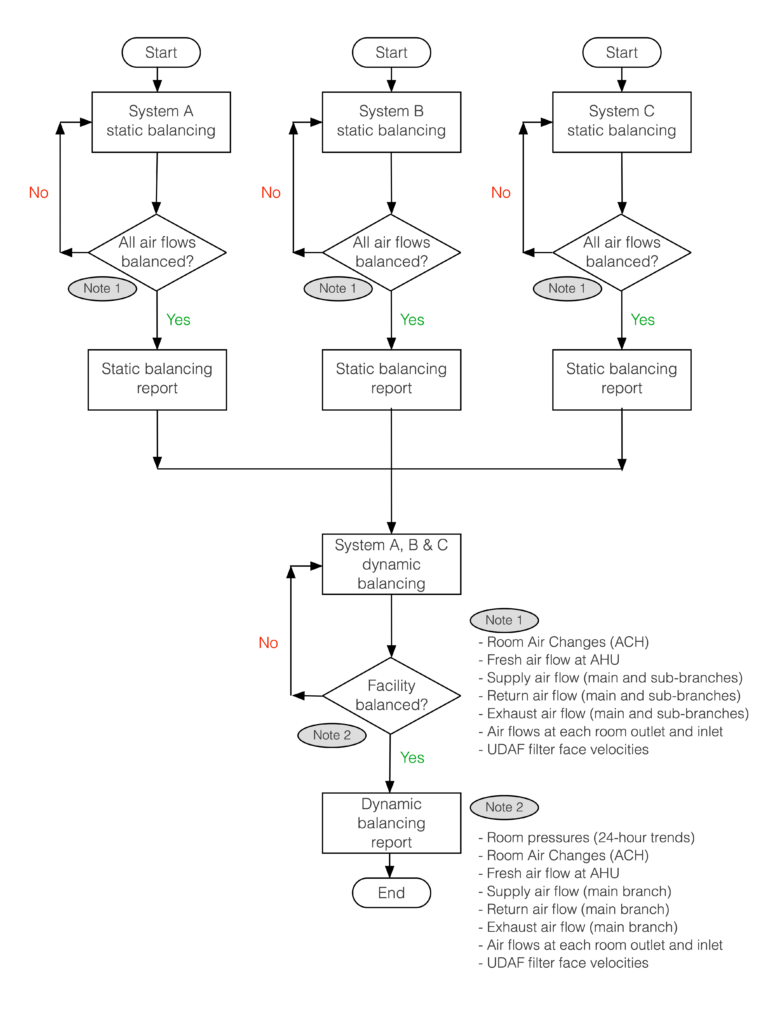How to do Air Balancing for a Biopharma Facility?
Air balancing is often a confusing affair in biopharma projects. Most people underestimate the steps, durations and complications involved in this activity, which is anything but a straight-line affair. This post attempts to share an overview of this elephant called “air balancing.”
The end game
Before we dive into the specific question, let’s ask: What’s the final objective of so-called “air balancing” in a biopharma facility?
On the face of it, the purpose is simple: Adjusting and balancing the fresh, supply, return and exhaust air flows as per the design for all Air Handling Unit (AHU) systems across the facility. But is that the bottom line? Not really! That’s just the means to an end.
The end is to ensure the following as per the design:
- Room supply air changes (ACH)
- Room pressures
- Filter face velocities (in case you’ve Unidirectional Airflow (UDAFs) Hoods)
- Any specific exhaust air flows (e.g., chemicals exhaust)
If you go a step deeper, you’ll realize all these four parameters ultimately lead to the GMP conditions in terms of room cleanliness (classification) and pressure cascade.
So what it takes?
Key steps
Air balancing is done in two stages:
- Static balancing
- Dynamic balancing
The flowchart below shows the overall sequence of steps.

Static balancing
Static balancing is the first activity after the system start-up and AHU testing. The purpose of this first stage of balancing is to adjust the fresh, supply, return and exhaust air flows as per the design values. This is, of course, done by adjusting the manual dampers in the ducts, CAVs (constant air volume boxes) and VAVs (Variable Air Volume boxes). In addition, it also involves adjusting the air flows at the individual supply air outlets and return/exhaust air inlets on the room side.
Important to note that during static balancing, you don’t bother about the room pressures. And if there are VAVs in the return/exhaust air, these are fixed/locked to design flows. In other words, the system is in static mode and not responding to any room pressure changes.
Static balancing is done system by system. If the static balancing is successful for a system, the balancing company submits a report that includes (at minimum):
- Room Air Changes (ACH)
- Fresh air flow at AHU
- Supply air flow (main and sub-branches)
- Return air flow (main and sub-branches)
- Exhaust air flow (main and sub-branches)
- Air flows at each room outlet and inlet
- UDAF filter face velocities (where applicable)
After each of the systems is statically balanced (which means all the above items comply with the acceptance criteria), the game shifts to the next stage, “dynamic balancing.”
Dynamic balancing
Before dynamic balancing starts, each AHU system should be statically balanced. That’s an important prerequisite to moving to this stage.
What happens during the dynamic balancing?
You simply release the VAVs (if applicable) to operate on room pressures and start monitoring the room pressures. As we all know, a pressure cascade (min. 10-15 Pa pressure difference between rooms of different grades) is a super-critical requirement for a biopharma facility. If VAVs are not there, then one goes about adjusting CAVs or manual dampers on the return/exhaust side to get the design room pressures.
During dynamic balancing, the core objective is to get the pressures right, and ideally, that can be achieved by tweaking the return/exhaust air flows in the rooms. Sometimes, you may need to adjust the supply flows from what was set during the static balancing, but that should be a last resort.
Once pressures are as required and stable, we are close to the end. This is the time to remeasure the following:
- Room pressures (minimum 24-hour trends)
- Room air changes (ACH)
- Fresh air flow at AHU
- Supply air flow (main branch)
- Return air flow (main branch)
- Exhaust air flow (main branch)
- Air flows at each room outlet and inlet
- UDAF filter face velocities (where applicable)
If any values do not meet the acceptance criteria, more adjustments are needed. As simple as that!
Some people will argue against the need to remeasure the fresh and supply air flows again if these were not touched during the dynamic balancing. Theoretically, that argument sounds smart, but practically, things can change during dynamic balancing even if you don’t touch them. It’s never a good idea to put in tremendous effort during the dynamic balancing—and then take a small shortcut by ignoring the fresh and supply air flow measurements.
Anyone involved in dynamic balancing knows one stark truth: it’s never a straight-line affair but always an iterative activity. You may move three steps forward, and the next day, it may be two steps back. Patience and keeping an eye on the final outcome are the keys to getting it right in the end.
That’s the story of air balancing in a nutshell.
- Note: Sometimes, people use the term “rough balancing” for static balancing and “final balancing” for dynamic balancing.
- Point to ponder: Why the flowchart above shows three separate boxes for static balancing (System A, B & C) but one combined box for all three systems for dynamic balancing?

Hi Atul,
Good Article same as my experiences. As for the point to ponder, my response will be: each system will have its own fresh, supply, return/exhaust design flow to be achieved in static balancing, these can be worked separately. As for the dynamic balancing, it involve room pressure and casade, so the 3 systems have to work together to achieve the desired room pressure and casade.
Regards,
Dickson
Dickson, thanks for reading. You’re right: Unlike static balancing, dynamic balancing can only be done in an integrated way with all systems working together. And that’s the message from that one box for all three systems.